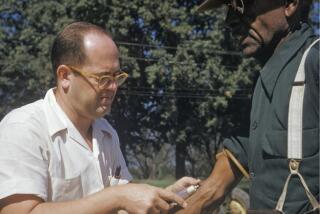Rand Economic Study Sees Spectacular Gains by Middle-Class Blacks
- Share via
Middle- and upper-class blacks have come to vastly outnumber poor blacks, a historic reversal from 40 years ago, according to a Rand Corp. study released Monday.
Relying on data from five censuses, Rand reported a “spectacular” growth in the size of the black middle class from 1940 to 1980.
In 1940, the study said, 24% of black men were middle or upper class, as compared to 70% of white men.
By 1980, 80% of black men were middle or upper class, as compared to 89% of white men.
A middle-class wage earner was defined as one who brought in between $7,000 and $31,000 a year in 1980, said one of the study’s authors, James P. Smith, a senior economist at Rand, a Santa Monica-based think tank.
The study was sponsored by the U.S. Department of Labor. Smith’s co-author was Finis R. Welch, chairman of Unicon Research Corp.
The study’s findings “belie . . . the widely held view that the relative economic position of blacks in America has been stagnant,” its authors said.
In 1940, they said, the average black male worker earned only 43% as much as his white counterpart. By 1980, the gap had narrowed, but was still large: black male workers on the average earned three quarters as much as whites.
Still, the study noted, “for the first time in American history, a sizable number of black men are economically better off than white middle-class America.” By 1980, it said, 29% of working black men had incomes above those of the average working white man.
Despite these changes, the study said, “many blacks remained left out and left behind.”
By 1980, 20% of working black men were poor--a reduction from 75% in 1940.
Gains were not as pronounced among black families as they were among black male workers, the report said.
Thirty percent of black families were below the poverty line in 1980, the report found. And 30% of black families had also been below the poverty line in 1970. Until then, the study said, reductions in black family poverty had moved “in lock step” with reductions in the number of black working men who were poor.
The report attributed the stagnation in the ability of black families to climb their way out of poverty to an increase in the number of black families headed by women: from 18% in 1940, to 20% in 1960, to 40% in 1980.
More than half of all black families headed by women were poor in 1980, the report said.
The study, billed as the most comprehensive look at the economic status of blacks in 40 years, noted that two-thirds of the 40-year reduction in black poverty took place by 1965, before the War on Poverty was officially launched.
It attributed the gains to longer and better schooling available to blacks, to black migration from the rural South to urban centers, and to a robust national economy that benefited both blacks and whites.
It found that affirmative action programs, begun in the middle 1960s, had little or no impact on the average black. Such programs helped mainly young, college-educated blacks, the study found.
The study found that affirmative action had resulted in “a radical reshuffling” of the black labor force, with black workers gravitating to employers covered by Equal Opportunity Employment Commission regulations--generally employers of 100 or more--or employers who must comply with affirmative action because they have federal contracts.
‘Many Gains Were Real’
“We found evidence that firms have begun reclassifying jobs held by blacks into the professional and managerial categories, in order to inflate overall minority representation,” the report said. “But many of the gains in the covered sector were real.”
However, the report said, “affirmative action apparently had no significant long-run impact, either positive or negative, on the male racial wage gap.
“The general pattern is that the narrowing of the racial wage gap was as rapid in the 20 years prior to 1960 (and before affirmative action) as during the 20 years afterwards.
“This suggests that the slowly evolving historical forces . . . education and migration . . . were the primary determinants of long-term black economic improvement. At best, affirmative action has marginally altered black wage gains . . . Young college educated blacks were the main beneficiaries of affirmative action.”
Findings Criticized
Those conclusions triggered criticisms Monday from spokesmen for the National Assn. for the Advancement of Colored People and the Urban League, who were asked for their reactions.
“It shows mental poverty for someone to suggest that,” said Jerry Guess, deputy communications director for the national NAACP, when a portion of the report was read to him. “There’s no body of evidence that shows that affirmative action has not benefitted blacks at all levels.”
John Mack, president of the Los Angeles Urban League, called the affirmative action evaluation “either a misinterpretation of the facts or a distortion of the facts.”
The Rand study identified longer and better quality schooling as the most important factors behind black economic advances. Length of schooling for the average black man increased from less than five years in 1940 to about 11 years in 1980, the report said. Over the same span, length of schooling for the average white man increased from nine years to 12 1/2, the report said.
Following schooling in importance was a major black migration from the South to the North, where wages were generally higher, from 1940 to 1970, the report said.
Since 1970, the report noted, gains have been harder because of a sluggish and erratic economy, and an unemployment rate among black youth that, at 22% in 1980, was more than double the rate for white youth.
More to Read
Sign up for Essential California
The most important California stories and recommendations in your inbox every morning.
You may occasionally receive promotional content from the Los Angeles Times.













